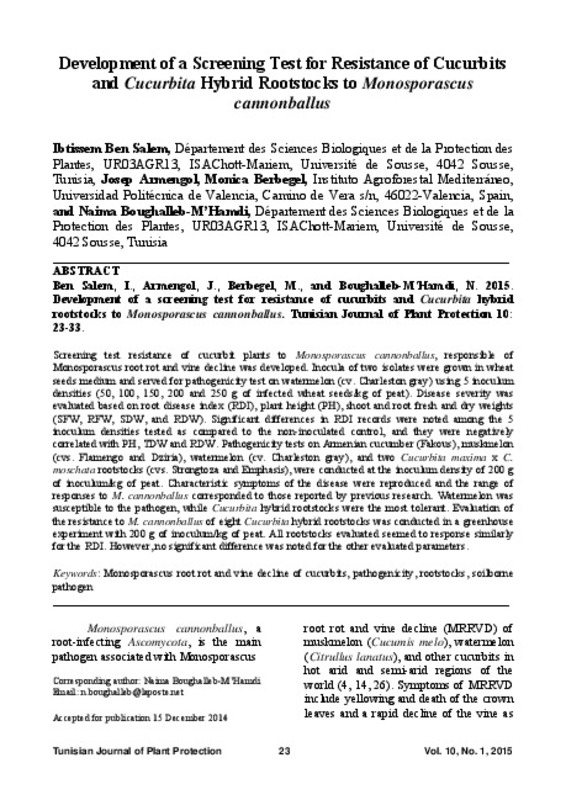JavaScript is disabled for your browser. Some features of this site may not work without it.
Buscar en RiuNet
Listar
Mi cuenta
Estadísticas
Ayuda RiuNet
Admin. UPV
Development of a screening test for resistance of cucurbits and Cucurbita hybrid rootstocks to Monosporascus cannonballus
Mostrar el registro sencillo del ítem
Ficheros en el ítem
| dc.contributor.author | Ben Salem, Ibtissem
|
es_ES |
| dc.contributor.author | Armengol Fortí, Josep
|
es_ES |
| dc.contributor.author | Berbegal Martínez, Mónica
|
es_ES |
| dc.contributor.author | Boughalleb-Mhamdi, N.
|
es_ES |
| dc.date.accessioned | 2018-05-13T04:25:47Z | |
| dc.date.available | 2018-05-13T04:25:47Z | |
| dc.date.issued | 2015 | es_ES |
| dc.identifier.issn | 1737-5436 | es_ES |
| dc.identifier.uri | http://hdl.handle.net/10251/101851 | |
| dc.description.abstract | [EN] Screening test resistance of cucurbit plants to Monosporascus cannonballus, responsible of Monosporascus root rot and vine decline was developed. Inocula of two isolates were grown in wheat seeds medium and served for pathogenicity test on watermelon (cv. Charleston gray) using 5 inoculum densities (50, 100, 150, 200 and 250 g of infected wheat seeds/kg of peat). Disease severity was evaluated based on root disease index (RDI), plant height (PH), shoot and root fresh and dry weights (SFW, RFW, SDW, and RDW). Significant differences in RDI records were noted among the 5 inoculum densities tested as compared to the non-inoculated control, and they were negatively correlated with PH, TDW and RDW. Pathogenicity tests on Armenian cucumber (Fakous), muskmelon (cvs. Flamengo and Dziria), watermelon (cv. Charleston gray), and two Cucurbita maxima x C. moschata rootstocks (cvs. Strongtoza and Emphasis), were conducted at the inoculum density of 200 g of inoculum/kg of peat. Characteristic symptoms of the disease were reproduced and the range of responses to M. cannonballus corresponded to those reported by previous research. Watermelon was susceptible to the pathogen, while Cucurbita hybrid rootstocks were the most tolerant. Evaluation of the resistance to M. cannonballus of eight Cucurbita hybrid rootstocks was conducted in a greenhouse experiment with 200 g of inoculum/kg of peat. All rootstocks evaluated seemed to response similarly for the RDI. However, no significant difference was noted for the other evaluated parameters. | es_ES |
| dc.description.abstract | [FR] Un test de criblage de la résistance des plants de cucurbitacées à Monosporascus cannonballus, responsable du dépérissement a été développé. Deux isolats ont été cultivés sur des grains de blé et ont servi pour le test de la pathogénie sur la pastèque (cv. Charleston gray) selon 5 densités d¿inoculum (50, 100, 150, 200 et 250 g de grains de blé infectés/kg de tourbe). La sévérité de la maladie a été évaluée selon un indice de maladie racinaire (RDI), la hauteur de la plante (HP), les poids frais (SFW et RFW) et secs (SDW et RDW) des parties aérienne et racinaire. Une différence significative a été notée selon l¿indice RDI entre les 5 densités d'inoculum par rapport au témoin, et une corrélation négative avec la réduction des paramètres HP, SDW et RDW a été obtenue. Les tests de pathogénie sur trois espèces de cucurbitacées: concombre arménien (Fakous), melon (cvs. Flamengo et Dziria), pastèque (cv. Charleston gris) et deux porte-greffes Cucurbita maxima x C. moschata (cvs. Strongtoza et Emphasis), ont été effectuées à la densité de 200 g d'inoculum/kg de tourbe. Les symptômes caractéristiques de la maladie ont été reproduits et la gamme des réponses à M. cannonballus correspondaient à ceux rapportés dans la littérature. La pastèque s¿est montrée sensible à cet agent pathogène, tandis que les porte-greffes hybrides du genre Cucurbita étaient les plus tolérants. Un autre essai de la résistance à M. cannonballus a été réalisé sur huit porte-greffes hybrides du genre Cucurbita en culture sous serre avec 200 g d¿inoculum/kg de tourbe. Tous les porte-greffes paraissent réagir de la même façon concernant l¿indice RDI et des différences non significatives pour les autres paramètres évalués ont été notées. | es_ES |
| dc.language | Inglés | es_ES |
| dc.publisher | School of Agriculture of Kef | es_ES |
| dc.relation.ispartof | Tunisian Journal of Plant Protection | es_ES |
| dc.rights | Reconocimiento - No comercial (by-nc) | es_ES |
| dc.subject | Monosporascus root rot and vine decline of cucurbits | es_ES |
| dc.subject | Pathogenicity | es_ES |
| dc.subject | Rootstocks | es_ES |
| dc.subject | Soilborne pathogen | es_ES |
| dc.subject.classification | ECOSISTEMAS AGROFORESTALES (UPV) | es_ES |
| dc.subject.classification | BOTANICA | es_ES |
| dc.subject.classification | PRODUCCION VEGETAL | es_ES |
| dc.title | Development of a screening test for resistance of cucurbits and Cucurbita hybrid rootstocks to Monosporascus cannonballus | es_ES |
| dc.type | Artículo | es_ES |
| dc.rights.accessRights | Abierto | es_ES |
| dc.contributor.affiliation | Universitat Politècnica de València. Instituto Agroforestal Mediterráneo - Institut Agroforestal Mediterrani | es_ES |
| dc.contributor.affiliation | Universitat Politècnica de València. Departamento de Ecosistemas Agroforestales - Departament d'Ecosistemes Agroforestals | es_ES |
| dc.description.bibliographicCitation | Ben Salem, I.; Armengol Fortí, J.; Berbegal Martinez, M.; Boughalleb-Mhamdi, N. (2015). Development of a screening test for resistance of cucurbits and Cucurbita hybrid rootstocks to Monosporascus cannonballus. Tunisian Journal of Plant Protection. 10(1):23-33. http://hdl.handle.net/10251/101851 | es_ES |
| dc.description.accrualMethod | S | es_ES |
| dc.relation.publisherversion | http://www.iresa.agrinet.tn/tjpp/ | es_ES |
| dc.description.upvformatpinicio | 23 | es_ES |
| dc.description.upvformatpfin | 33 | es_ES |
| dc.type.version | info:eu-repo/semantics/publishedVersion | es_ES |
| dc.description.volume | 10 | es_ES |
| dc.description.issue | 1 | es_ES |
| dc.relation.pasarela | S\293047 | es_ES |






